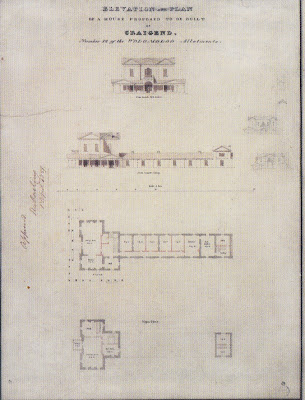Detail from elevation and plan of a house proposed to be built on Craigend, 1829, Number 12 of the Wolloomooloo Hill allotments. Artist unknown.
Craigend: allotment of over 9 acres granted to Sir Thomas Livingstone Mitchell in 1831.
Craigend was the first home to be built at the highest point of the Darlinghurst Ridge as part of the original development of the area in the 1820s and 1830s. The home was built for Sir Thomas Livingstone Mitchell, who arrived in Australia from Scotland in 1827 after being appointed the colony's Assistant Surveyor-General.
Mitchell was born in a house called Craigend in the town of Grangemouth, central Scotland, in 1792 and although poor was well educated. He could read in several languages and was proficient in science.
In his early 20s he was made a lieutenant of the 95th regiment and during the Peninsular war, between France and the allied powers of Spain, Portugal and the United Kingdom, he served in the Spanish towns of Ciudad Rodrigo, Badajoz and Salamanca.
His main role was to obtain topographical intelligence and these skills were noticed by the Quartermaster General, Sir George Murray, who employed him to produce plans of the major Iberian Peninsular battlefields.
After his marriage in June 1818, Sir Murray helped him land the role of Assistant Surveyor General in Sydney and in 1827, Mitchell and wife, Mary, arrived in Australia.
Mitchell actively petitioned for land on Woolloomooloo Hill (Darlinghurst) and in 1831 he was authorised to select an allotment. He chose a grant of just over nine acres positioned on the highest point of the ridge, where Royston Street is today.
Mitchell designed the villa, Craigend, and its Parthenon-style portico and elevated position on the hill led it to be known as the Acropolis of Sydney. But Mitchell's wild spending on such a grand mansion led him into financial trouble and in 1837 he was forced to subdivide his nine acres and sell the Craigend estate.
Until then, Mitchell was quite the adventurer.
The Survey Department was a schmozzle when he arrived. Surveying instruments were few and many of the staff were incompetent, so that title deeds were delayed and doubts and disputes arose about boundary lines. Tent poles were used to measure base lines, and hillsides with lone trees were used as trigonometrical points.
Mitchell inherited the position of Surveyor General in 1828 and the following year became responsible for the survey of roads and bridges. His work included making changes in the roads from Sydney to Parramatta and Liverpool, as well as plotting new courses to Berrima and Goulburn and a trail from the Blue Mountains to Bathurst. Many of the roads he plotted are much the same as the ones used today.
During his career in the 1830s, Mitchell also made expeditions to central, far-west and north-west NSW, to towns such as Orange, Menindee, Namoi, Tamworth and Narrabri.
On one expedition in February 1832, two of his party were killed by indigenous Australians near Moree. In March 1835, botanist Richard Cunningham was also killed by Aborigines at Bogan and on the same expedition the party encountered members of the Darling tribe who they described as ''implacably hostile and shamelessly dishonest''. During an affray with the group, shots were fired and several Aborigines were killed and wounded. Mitchell returned home.
Mitchell made a third expedition to plot out parts of the Darling and Murray rivers, but again his party got into strife with the locals and seven Aborigines were killed near Mount Dispersion.
An inquiry conducted into the deaths by the Executive Council in 1836 found that Mitchell had not made sufficient efforts to be conciliatory to the Aborigines but the council could not blame his ''want of coolness and presence of mind, which it is the lot of few men to possess''.
In 1837, Mitchell returned to the United Kingdom, wrote a book about his expeditions, begged for a knighthood and returned to Australia four years later as a Sir.
He briefly held an elected position on the Legislative Council and made a fourth expedition into the eastern interior of Australia.
During the 1840s he again returned to the United Kingdom but came back to Sydney to write another book, The Australian Geography, which placed Australia in the centre of the world map and became a school text in NSW in the 1850s.
Mitchell, who was a bit of a rogue in the colony and was regularly accused of insubordination, was also involved in one of the last duals in Australia with a chap called Stuart Donaldson who had publicly made some inaccurate, presumably defamatory, remarks about him. On September 27, 1851, each fired three shots and it was reported that one bullet went through Donaldson's hat while another went within an inch of Mitchell's throat.
In 1855, while surveying a line of road between Nelligen and Braidwood, south of Sydney, Mitchell developed pneumonia and died at his home in Sydney on October 5. Mary survived Mitchell but five of their 12 children did not.
Craigend, which Mitchell had sold years earlier, had a succession of owners and was later converted into a hospital, then a boarding house in the early 1900s. The Acropolis of Sydney was demolished in 1822 to make way for a large block of flats (below).



No comments:
Post a Comment